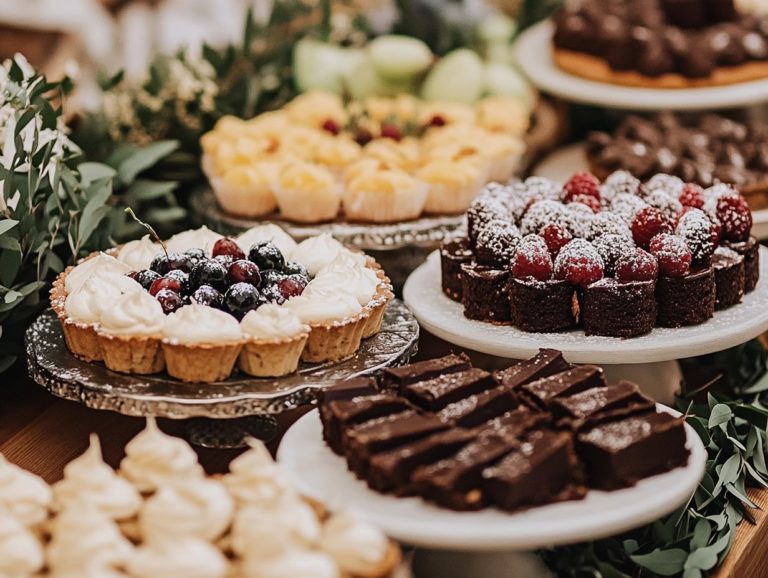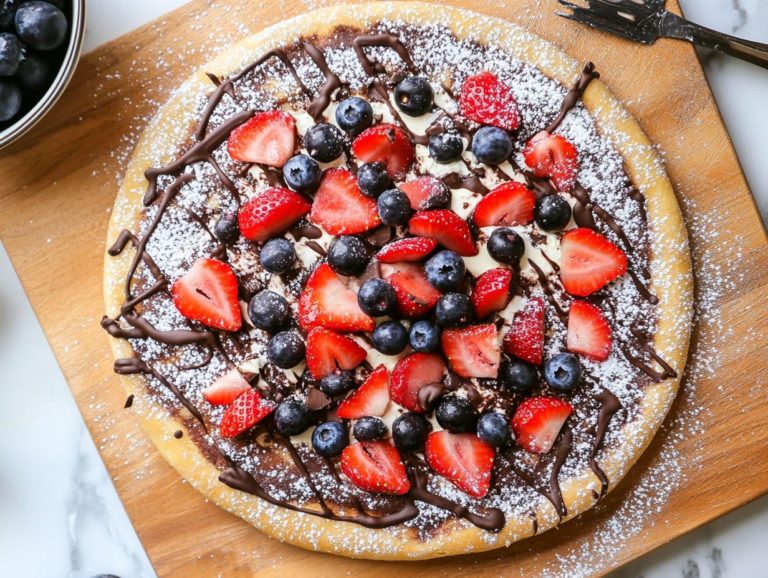How to Store Gluten-Free Desserts for Freshness
Navigating the world of gluten-free desserts and gluten-free baking can be a delightful culinary adventure! Mastering proper storage is crucial to preserving their freshness and flavor.
Understanding the unique storage requirements of these gluten-free treats, along with recognizing common mistakes that could compromise their quality, is essential for maintaining cookie freshness.
This guide provides you with everything you need to know about the best ways to refrigerate, freeze, and store your gluten-free desserts at room temperature. It also delves into shelf life, signs of spoilage, food preservation, and the ideal containers for optimal storage.
Get ready to savor your sweet creations to their fullest potential!
Contents
- Key Takeaways:
- What Is Gluten-Free Dessert?
- Why Is Proper Storage Important for Gluten-Free Desserts?
- How to Store Gluten-Free Desserts for Freshness?
- What Are the Shelf Life and Expiration Date of Gluten-Free Desserts?
- How to Tell if a Gluten-Free Dessert Has Gone Bad?
- What Are the Best Containers for Storing Gluten-Free Desserts?
- Tips for Storing Gluten-Free Desserts
- Frequently Asked Questions
- Can I store gluten-free desserts in the refrigerator?
- How should I store gluten-free desserts at room temperature?
- What is the best way to freeze gluten-free desserts?
- Can I store gluten-free desserts with non-gluten-free desserts?
- How long can I store gluten-free desserts for freshness?
- What are some tips for maintaining the freshness of gluten-free desserts?
Key Takeaways:

- Proper storage is crucial for maintaining the freshness and flavor of gluten-free desserts and baked goods.
- Refrigeration and freezing are the best methods for storing gluten-free desserts and ensuring their optimal cookie texture.
- Airtight containers, glass jars, plastic wrap or Ziploc bags, and Kraft bakery-style boxes from Amazon are recommended for storing gluten-free desserts, and they should be consumed within their designated shelf life.
What Is Gluten-Free Dessert?
Gluten-free dessert encompasses an array of delectable baked goods crafted without wheat flour, designed specifically for those adhering to a gluten-free diet, including individuals with celiac disease. You ll find a delightful selection of treats, from gluten-free cookies and brownies to gluten-free muffins and cakes, all made with gluten-free flours such as almond, coconut, or rice flour.
The gluten-free market has experienced remarkable growth as more people seek out these gluten-free alternatives, making it essential for you to delve into the enticing realm of gluten-free dessert recipes and innovative baking techniques.
Why Is Proper Storage Important for Gluten-Free Desserts?
Proper storage of gluten-free desserts is essential for maintaining their freshness and delivering a delightful experience for anyone following a gluten-free diet. Unlike traditional baked goods, gluten-free treats often possess distinct textures and moisture levels, making effective preservation techniques vital to prevent issues like crumbling cookies or stale flavors.
Embracing a gluten-free lifestyle means being mindful of how to store these baked goods correctly, allowing their freshness and taste to endure. This ensures that these delectable alternatives continue to bring joy to your palate.
What Are the Common Mistakes in Storing Gluten-Free Desserts?
You may not realize it, but many people stumble into common pitfalls when it comes to storing gluten-free desserts, leading to disappointing results like dry, crumbly cookies and stale flavors. One frequent mistake is failing to use airtight containers containers that prevent air from entering or appropriate wrapping methods, which can cause moisture loss or allow other odors to invade.
Improper temperature settings can negatively impact the texture and freshness of these delicate baked goods, making it essential for you to grasp the best practices for storing them. For instance, if you opt for plastic wrap instead of silicone or glass containers, you risk introducing unwanted air that compromises the integrity of your treats.
Overlooking the humidity levels in your environment can either turn your desserts soggy or cause them to dry out even more. To steer clear of these issues, it’s wise to store your gluten-free desserts in airtight containers, ideally glass, and keep them in a cool, dry place away from direct sunlight. When possible, refrigerating or freezing your creations can extend their shelf life without sacrificing texture or flavor, ensuring that every delightful bite remains just as enjoyable for longer.
How to Store Gluten-Free Desserts for Freshness?
To ensure your gluten-free desserts remain optimally fresh, it’s essential to employ methods specifically suited to each type of treat, whether you re dealing with cookies, brownies, or cakes. By utilizing proper storage techniques, you can significantly extend their shelf life while preserving their delightful textures and flavors.
For example, knowing how to keep gluten-free cookies in an airtight container at room temperature will work wonders. On the other hand, opting for freezer storage for long-term preservation can help you avoid common pitfalls associated with gluten-free baked goods, such as dryness or diminished flavor.
Try these storage methods today and keep your gluten-free treats as delicious as they were when you made them!
1. Refrigerating Gluten-Free Desserts
Want to keep your gluten-free desserts tasting fresh and delicious? Refrigerating gluten-free desserts is a smart strategy to extend their freshness, particularly for items like cakes and certain cookies that tend to dry out. By employing proper refrigeration techniques, you can preserve the texture and flavors of your gluten-free baked goods, allowing you to enjoy them for a longer period without compromising on quality.
For the best results, think about refrigerating classic gluten-free delights such as brownies, cheesecakes, and frostings. It’s crucial to wrap these treats tightly in plastic wrap or store them in airtight containers to prevent any moisture loss. Aim to set your refrigerator temperature between 35 F and 40 F to keep the desserts fresh while avoiding the risk of freezing.
Pay attention to the humidity levels within your fridge, as excess moisture can lead to sogginess or spoilage. By following these steps, you can truly enjoy the tasty goodness of gluten-free confections for an extended time.
2. Freezing Gluten-Free Desserts
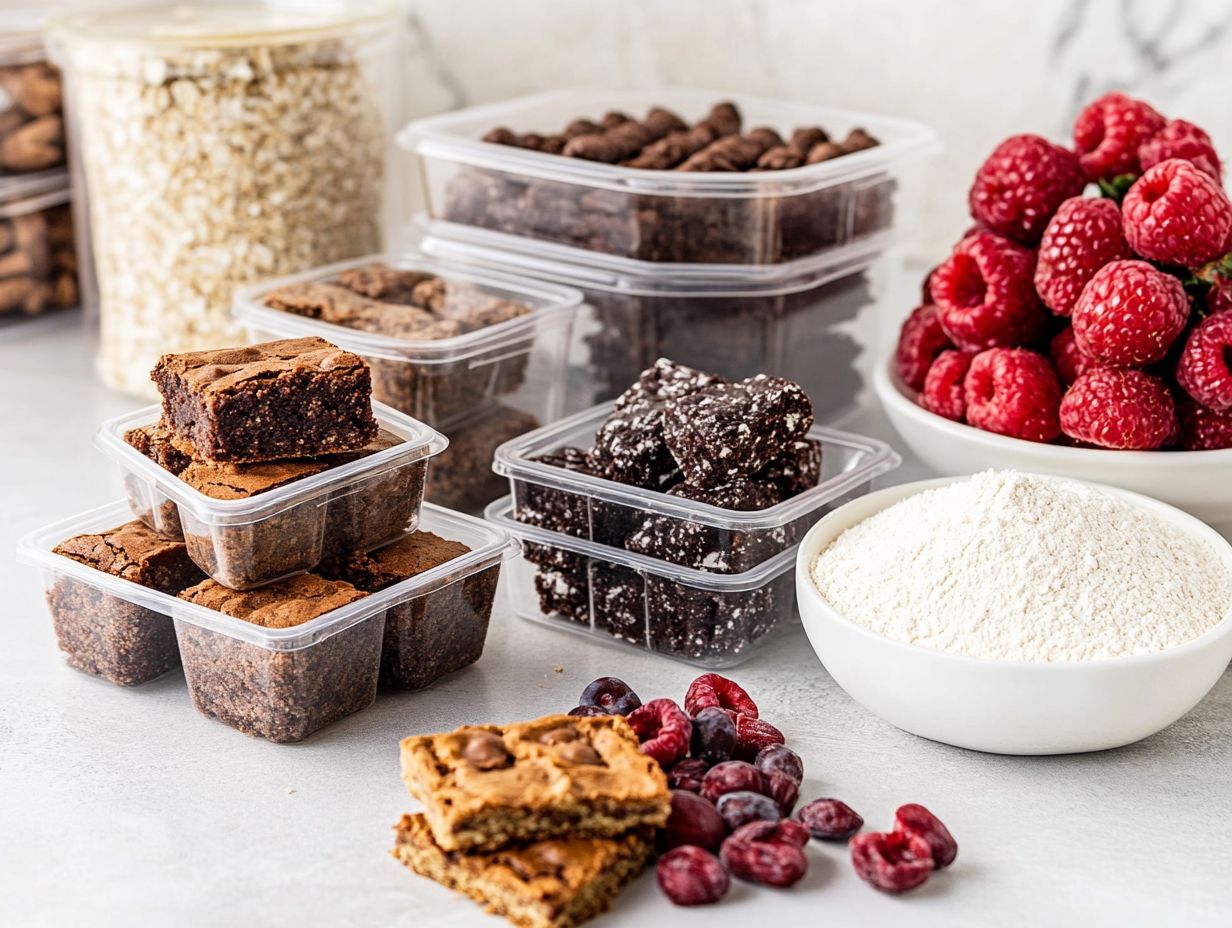
Freezing gluten-free desserts is an exceptional strategy for long-term storage, allowing you to enjoy your favorite treats at a later date without sacrificing their quality. Wrap them tightly in plastic wrap or aluminum foil to prevent freezer burn, which can cause ice crystals to form on your food and affect its taste. When properly frozen, gluten-free cookies, brownies, and cakes can maintain their tasty flavors and textures, making it an effective way to manage leftovers or prepare baked goods for shipping.
For additional protection, consider placing the wrapped items in airtight containers or heavy-duty freezer bags. Additionally, following cookie shipping rules can ensure your cookies arrive fresh and intact when mailing cookies to loved ones.
Most gluten-free desserts can be stored in the freezer for up to three months, but some may last even longer if packaged correctly. When you re ready to indulge in these frozen delights, simply thaw them in the refrigerator overnight. This method allows the desserts to regain their moisture without becoming soggy, ensuring they taste just as incredible as when they were freshly baked.
3. Room Temperature Storage
Storing gluten-free desserts at room temperature can be a superb choice for preserving their texture and flavor, particularly for baked treats you plan to enjoy within a few days. It s essential to choose the right containers and wraps to keep these gluten-free delights fresh and tasty.
Opt for airtight containers that create a moisture-resistant seal; this approach will help prevent your desserts from becoming stale due to unwanted humidity. For example, cookies, brownies, and bars often thrive in these conditions, happily residing on your countertop for a short time. However, be mindful of highly humid environments, as they can quickly lead to the deterioration of gluten-free baked goods. Keeping them in a cool, dry area of your home is key.
Consider layering parchment paper for the more delicate items. This technique helps preserve their integrity while allowing for easy access when that irresistible sweet craving strikes.
What Are the Shelf Life and Expiration Date of Gluten-Free Desserts?
Grasping the nuances of shelf life and expiration dates for gluten-free desserts is crucial for anyone adhering to a gluten-free diet, whether you’re whipping up treats in your kitchen or shopping at a specialty store. For further insights, resources like Hopkins Medicine and Celiac.com provide valuable information on gluten-free food.
Regarding homemade gluten-free desserts, you ll find that they generally have a shorter shelf life than their store-bought counterparts, primarily due to the lack of preservatives. This absence can significantly influence their freshness and texture as time goes by.
1. Homemade Gluten-Free Desserts
Homemade gluten-free desserts typically boast a shelf life of about 3 to 5 days when kept at room temperature, though this can vary based on the ingredients and storage methods you employ. It’s crucial to recognize that factors like humidity and baking techniques can significantly influence their freshness, making adherence to proper storage guidelines essential for savoring the best quality.
The choice of ingredients and the unique properties of gluten-free alternatives play a pivotal role in determining texture and moisture retention. For example, desserts crafted with almond flour or coconut flour may possess a different shelf life than those made with rice flour, all due to the varying oil content and absorbency of these ingredients.
Want to keep your desserts fresh? Refrigerate treats that contain dairy or are very moist; this simple step can potentially extend their lifespan to a week or even longer. Utilizing airtight containers is imperative to minimize exposure to air and humidity, preserving the integrity of your delightful creations. For additional baking tips and techniques, websites like Food52 and Modernist Cuisine can offer helpful advice.
If you find yourself needing to store your desserts for a more extended period, freezing is a highly effective option. When executed correctly, this method can retain both flavor and texture, allowing you to enjoy your gluten-free desserts as if they were freshly made. This technique is especially useful for those who love gluten-free baking and want to keep their baked goods fresh for longer.
2. Store-Bought Gluten-Free Desserts
Store-bought gluten-free desserts often boast a longer shelf life thanks to the use of preservatives and clever packaging techniques designed to maintain freshness. Typically, these delightful treats can last anywhere from several weeks to months while unopened. However, once you crack them open, the clock starts ticking, and their shelf life can diminish quite rapidly. Proper storage of these baked treats is essential for maintaining their quality.
This extended freshness is particularly advantageous for those with gluten sensitivities or who follow a gluten-free diet, allowing you to indulge in a greater variety of sweet delights without the nagging concern of spoilage. Shelf-stable options frequently rely on preservatives that thwart mold growth and slow oxidation, making them especially convenient for those with busy lifestyles who may not get around to enjoying their treats right away.
To ensure you re getting the best out of your desserts, it s crucial to keep an eye on the expiration dates printed on the packaging. Storing opened products in cool, dry places ideally in airtight containers will help minimize their exposure to air and moisture. By following these simple tips, you can relish your gluten-free desserts for even longer. This is a key aspect of storing baked goods effectively.
How to Tell if a Gluten-Free Dessert Has Gone Bad?
Determining whether a gluten-free dessert has gone bad is crucial for ensuring both safety and enjoyment. You ll want to keep an eye out for common signs of spoilage, such as changes in texture, unusual smells, or the presence of visible mold these are all indicators that the dessert is no longer safe to consume. Being vigilant about these signs can help you avoid any unpleasant surprises and guarantee that you re savoring only the freshest gluten-free treats.
For example, if the texture of a once-fluffy cake turns dense or overly soggy, it s likely a red flag that it has started to deteriorate. A sour or odd odor can hint at fermentation or spoilage, particularly in desserts that contain dairy or fruit. Mold can manifest as green, blue, or white spots, and you should always dispose of the entire item immediately if you spot any. This is crucial for maintaining the quality of your gluten-free baked goods.
To maintain safety, it s wise to adhere to expiration dates on packaged goods, and if you have any doubts, trust your instincts when in doubt, throw it out. By taking these precautions, you can protect yourself against health issues and preserve the integrity of your gluten-free delights.
What Are the Best Containers for Storing Gluten-Free Desserts?
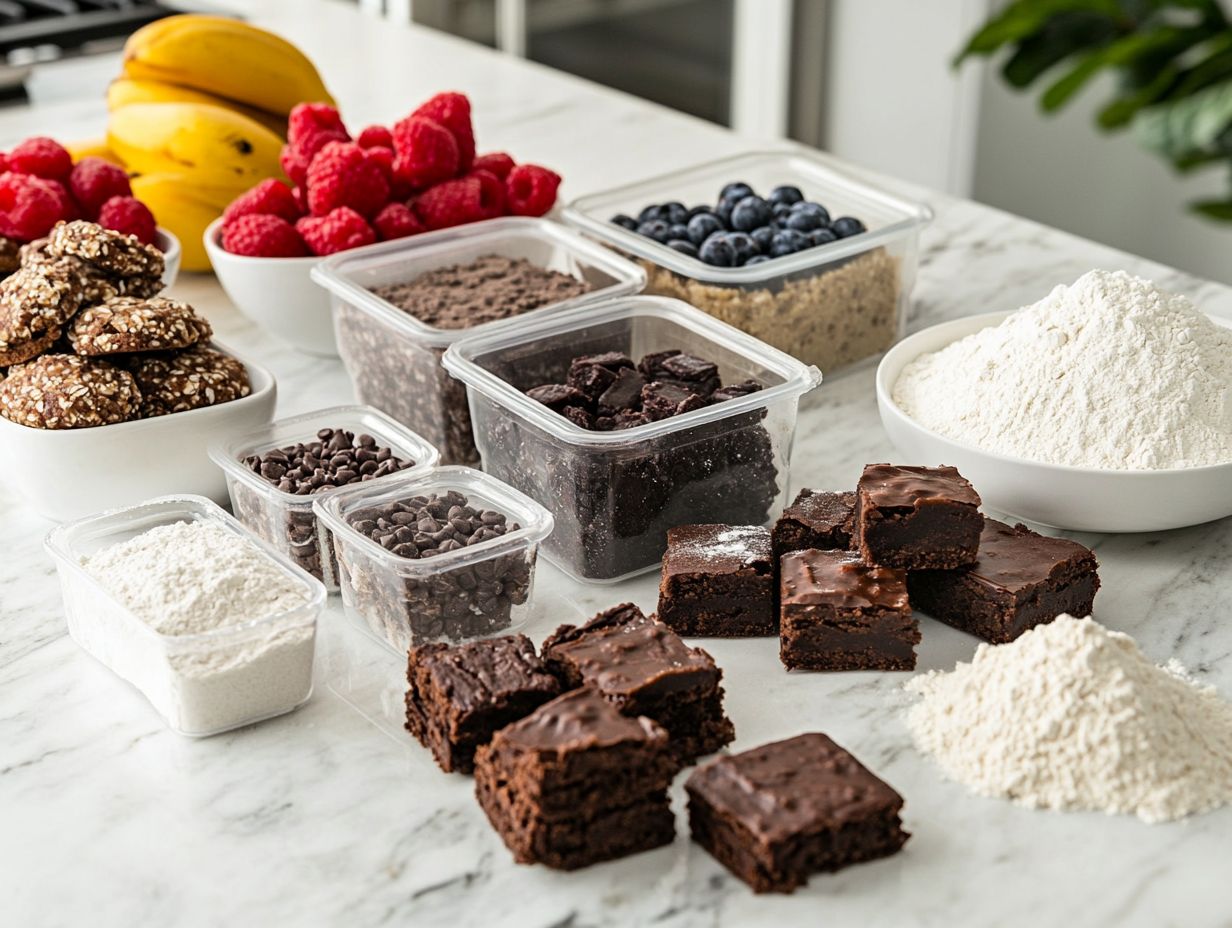
Selecting the right containers for storing your gluten-free desserts is vital for preserving their freshness and quality. Opting for airtight containers is crucial to maintain the texture and flavor of your gluten-free treats. They protect against air, moisture, and odors that could jeopardize their integrity. This step is essential for food preservation.
Whether you re stashing away cookies, brownies, or cakes, making the right choice in storage can significantly extend the life of your delicious creations.
1. Airtight Containers
Airtight containers are some of the finest choices for storing your gluten-free desserts. They effectively reduce air contact, which can lead to staleness and spoilage. By using these containers, you can ensure that your gluten-free cookies, brownies, and other baked delights retain their intended texture and flavor for an extended period.
This preservation is vital for gluten-free treats. They are more likely to dry out or absorb unwanted odors. To maximize their benefits, consider the size and material of your container; silicone or glass options stand out as excellent choices due to their durability and their ability to resist retaining smells. This practice is beneficial for baking storage.
Choosing the right container size is vital. A container that is too large can create unnecessary air space, while one that is too small might squish your delicate desserts. By thoughtfully selecting your storage solutions, you can keep these delightful treats incredibly fresh and ready to enjoy!
2. Glass Jars
Glass jars serve as an exceptional storage solution for your gluten-free desserts. They provide an elegant way to display your treats while keeping them fresh. These jars create a sealed environment that protects your cookies and cakes from air and moisture, significantly extending their shelf life. This method is often used in gluten-free baking.
Beyond their practicality, glass jars enhance your kitchen decor by showcasing a delightful array of colors and textures. When selecting jars, consider their size and shape based on the types of treats you have in mind. Smaller jars are ideal for storing bite-sized cookies, while larger jars can easily accommodate gluten-free cakes or brownies.
It’s also wise to choose jars with wide openings for easier access, especially for those layered desserts or treats topped with delicious goodies. By using jars of varying sizes, you can effectively organize your baked goods. This ensures that your gluten-free delights are safe from spoilage and beautifully displayed for all to admire. This is a common practice in the gluten-free market.
3. Plastic Wrap or Ziploc Bags
Utilizing plastic wrap or Ziploc bags for storing your gluten-free desserts is a smart and effective way to keep them fresh. This is particularly true for individual servings of cookies or brownies. These materials create a tight seal that minimizes air exposure and moisture loss, making them perfect for quick storage solutions. This is especially useful for freezer storage.
These flexible options cater beautifully to the unique shapes and sizes of your gluten-free treats. They offer a level of customization that rigid containers simply can’t provide. When you use plastic wrap, ensure it snugly envelops the dessert, eliminating any air pockets that could lead to staleness. For Ziploc bags, gently pressing out any excess air before sealing is key to maintaining maximum freshness. This technique is particularly useful for baking techniques.
This method shines when you need quick access or are transporting your desserts, as the lightweight materials take up minimal space.
While these strategies work wonders for short-term storage, it s wise to transition to sturdier containers for longer preservation. This will safeguard your delicious creations against potential crushing or damage, ensuring they remain as delightful as the day you made them. This is a critical strategy in storing baked goods.
Tips for Storing Gluten-Free Desserts
Storing gluten-free desserts effectively demands your keen attention to detail. A few strategic tips can help maintain their freshness and quality over time. By using proper storage methods, you can sidestep common pitfalls like stale flavors and crumbling cookies, ensuring that you relish every bite of your gluten-free baked creations.
From selecting the ideal containers to keeping desserts at the right temperature, these practical insights will undoubtedly elevate your dessert experience.
For additional tips and tricks on storing and maintaining your gluten-free desserts, check out resources from Celiac.com and Love Health.
Frequently Asked Questions
Can I store gluten-free desserts in the refrigerator?
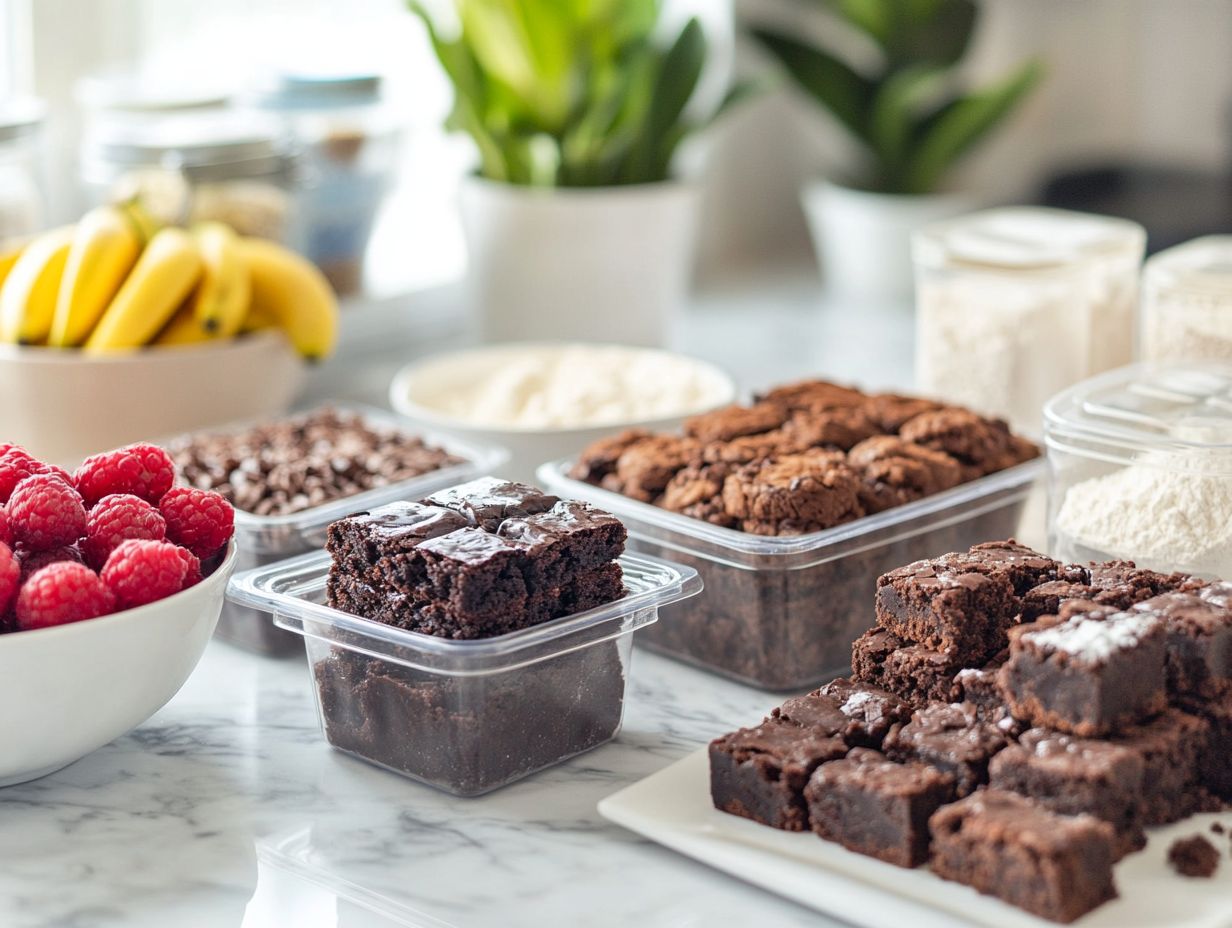
Yes, gluten-free desserts can be stored in the refrigerator to help keep them fresh. However, be sure to wrap them tightly or place them in an airtight container to prevent them from drying out. This is part of effective food preservation.
How should I store gluten-free desserts at room temperature?
If you plan on storing gluten-free desserts at room temperature, keep them in a cool, dry place. Avoid placing them near sources of heat or direct sunlight, as this can cause them to spoil more quickly. Pay attention to temperature control to keep desserts fresh.
What is the best way to freeze gluten-free desserts?
To freeze gluten-free desserts, wrap them tightly in plastic wrap and place them in an airtight container or freezer bag. This will help prevent freezer burn and maintain their freshness. Be sure to label the container with the name and date of the dessert for easy identification. This technique is particularly useful for freezing cookies and other baked goods.
Can I store gluten-free desserts with non-gluten-free desserts?
No, it is not recommended to store gluten-free desserts with non-gluten-free desserts. This can lead to cross-contamination and potentially cause a reaction for those with gluten sensitivities. It is best to store them separately or label them clearly to avoid any mix-ups. Understanding cookie shipping rules can also be helpful in this context.
How long can I store gluten-free desserts for freshness?
The storage time for gluten-free desserts varies depending on the type of dessert and how it is stored. Generally, they can be kept in the refrigerator for up to 3-4 days and in the freezer for up to 3-4 months. Be sure to check for any signs of spoilage before consuming.
What are some tips for maintaining the freshness of gluten-free desserts?
To keep gluten-free desserts fresh, store them properly in a cool, dry place. Avoid exposing them to heat or moisture, and wrap them tightly to prevent them from drying out. It is also important to consume them within a reasonable time for the best taste and texture. Always follow reliable baking tips to ensure optimal results.
Try these tips today to ensure your gluten-free desserts stay delicious and fresh!

